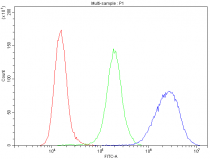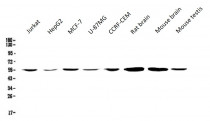ARG59658
anti-CD193 / CCR3 antibody
anti-CD193 / CCR3 antibody for Flow cytometry,Western blot and Human,Mouse,Rat
Overview
| Product Description | Rabbit Polyclonal antibody recognizes CD193 / CCR3 |
|---|---|
| Tested Reactivity | Hu, Ms, Rat |
| Tested Application | FACS, WB |
| Host | Rabbit |
| Clonality | Polyclonal |
| Isotype | IgG |
| Target Name | CD193 / CCR3 |
| Antigen Species | Human |
| Immunogen | Synthetic peptide corresponding to a sequence of Human CCR3. (MTTSLDTVETFGTTSYYDDVGLLCEKADTRALMA) |
| Conjugation | Un-conjugated |
| Alternate Names | C-C chemokine receptor type 3; CD193; CKR3; CCR-3; Eosinophil eotaxin receptor; CMKBR3; C-C CKR-3; CCR3; CC-CKR-3; CD antigen CD193 |
Application Instructions
| Application Suggestion |
|
||||||
|---|---|---|---|---|---|---|---|
| Application Note | * The dilutions indicate recommended starting dilutions and the optimal dilutions or concentrations should be determined by the scientist. |
Properties
| Form | Liquid |
|---|---|
| Purification | Affinity purification with immunogen. |
| Buffer | 0.9% NaCl, 0.2% Na2HPO4, 0.05% Sodium azide and 4% Trehalose. |
| Preservative | 0.05% Sodium azide |
| Stabilizer | 4% Trehalose |
| Concentration | 0.5 mg/ml |
| Storage Instruction | For continuous use, store undiluted antibody at 2-8°C for up to a week. For long-term storage, aliquot and store at -20°C or below. Storage in frost free freezers is not recommended. Avoid repeated freeze/thaw cycles. Suggest spin the vial prior to opening. The antibody solution should be gently mixed before use. |
| Note | For laboratory research only, not for drug, diagnostic or other use. |
Bioinformation
| Database Links | |
|---|---|
| Gene Symbol | CCR3 |
| Gene Full Name | chemokine (C-C motif) receptor 3 |
| Background | The protein encoded by this gene is a receptor for C-C type chemokines. It belongs to family 1 of the G protein-coupled receptors. This receptor binds and responds to a variety of chemokines, including eotaxin (CCL11), eotaxin-3 (CCL26), MCP-3 (CCL7), MCP-4 (CCL13), and RANTES (CCL5). It is highly expressed in eosinophils and basophils, and is also detected in TH1 and TH2 cells, as well as in airway epithelial cells. This receptor may contribute to the accumulation and activation of eosinophils and other inflammatory cells in the allergic airway. It is also known to be an entry co-receptor for HIV-1. This gene and seven other chemokine receptor genes form a chemokine receptor gene cluster on the chromosomal region 3p21. Alternatively spliced transcript variants have been described. [provided by RefSeq, Sep 2009] |
| Function | Receptor for a C-C type chemokine. Binds to eotaxin, eotaxin-3, MCP-3, MCP-4, RANTES and MIP-1 delta. Subsequently transduces a signal by increasing the intracellular calcium ions level. Alternative coreceptor with CD4 for HIV-1 infection. [UniProt] |
| Cellular Localization | Cell membrane; Multi-pass membrane protein. [UniProt] |
| Calculated MW | 41 kDa |
Images (2) Click the Picture to Zoom In
-
ARG59658 anti-CD193 / CCR3 antibody FACS image
Flow Cytometry: RAW264.7 cells were blocked with 10% normal goat serum and then stained with ARG59658 anti-CD193 / CCR3 antibody (blue) at 1 µg/10^6 cells for 30 min at 20°C, followed by DyLight®488 labelled secondary antibody. Isotype control antibody (green) was Rabbit IgG (1 µg/10^6 cells) used under the same conditions. Unlabelled sample (red) was also used as a control.
-
ARG59658 anti-CD193 / CCR3 antibody WB image
Western blot: 50 µg of samples under reducing conditions. Jurkat whole cell lysates, HepG2 whole cell lysates, MCF-7 whole cell lysates, U-87MG whole cell lysates, CCRF-CEM whole cell lysates, Rat brain lysates, Mouse brain lysates and Mouse testis lysates stained with ARG59658 anti-CD193 / CCR3 antibody at 0.5 µg/ml, overnight at 4°C.







